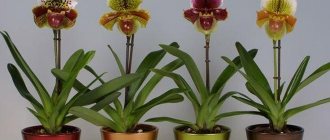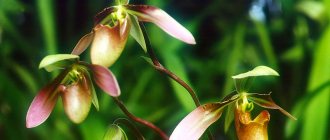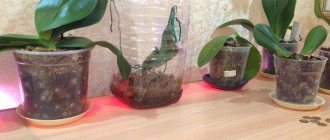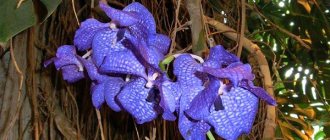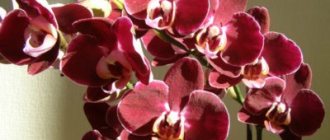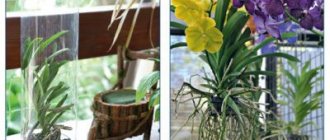Origin of the orchid
In the wild, Paphiopedilum prefers the territory of Southeast Asia, since it thrives best in subtropical, monsoon and tropical climates. If we talk about the literal translation, then paphiopedilum is translated as “slipper from Paphos”, and Paphos is considered the birthplace of Venus. This is where the popular name came from - lady's slipper.
This orchid even has its own legend, according to which Venus really wanted to be alone with her lover and, while rushing to meet Adonis, lost her golden slipper right in the middle of the forest. A hunter passing in these places discovered the loss and wanted to pick it up from the ground, but the shoe instantly turned into a beautiful and delicate flower. This orchid is the true embodiment of tenderness, grace and sophistication.
History, origin and place of residence
English botanist John Lindsay studied this genus of orchid in 1737. These flowers can be found on the border of Northern Vietnam and Southern China and India. In Russia, extremely rarely, you can see this plant in the Far East, Crimea and Western Siberia.
Paphiopedilum is the scientific name of this orchid and is translated as “slipper from Paphos,” the city in Cyprus where the goddess of love was born.
Detailed description of appearance:
- The buds are silky and large, consisting of petals of bizarre shapes.
- The petals are dense.
- Known for its varied shades.
- The stem is long and straight.
- The roots are horizontal, brown in color.
- The leaves are dark green.
Description of the plant
The roots of a healthy plant should be brown and covered with fine fibers. When a period of active development begins, their tips become noticeably white. The rosette can be formed from leaves of different shapes, which can be belt-shaped or broad-linear. They have a beautiful, rich green hue, and you can even see patterns on some.
One rosette can bloom only once. The peduncle can have a length from 4 to 60 cm. Only one shoe is formed on it. Most species of this plant have very bright flowers and come in various shades of red, yellow and green. The lip especially stands out: it is the one that attracts insects, who like not only its brightness and beauty, but also its sweet honey aroma.
How to choose a slipper orchid and what to do immediately after purchase
Orchid slipper after purchase how to care
Blackening of the stem and spots on the leaves “say” to definitely refuse the purchase. An outwardly healthy orchid can be infested with pests. For the first 7-10 days after purchase, you need to keep the flower separate from the rest. If you find harmful insects, take appropriate measures (this is discussed in detail in the section on diseases and pests).
After quarantine or final disposal of pests, the plant should be replanted.
Planting a lady's slipper
Lady's slippers are planted in opaque pots, which should be made of plastic or ceramics. You should choose a pot of such a size that it exactly matches the size of the plant’s root system. You can also use a transparent container. This is usually done in order to constantly monitor the condition of the roots and lower layers of the substrate.
In general, young plants are usually replanted every year. You can do this a little less often (once every two or three years), but for this there must be at least one of the following reasons:
- ten or more rosettes were formed in the pot;
- the flower has a young growing shoot and there is a desire to propagate the plant by division;
- flowering has just finished;
- By observing the condition of the lower layers of the substrate, the gardener sees that salinization of the soil is occurring, which affects the condition of the plant.
Some gardeners who have orchids recommend updating the soil a little every six months.
Required soil
Making a substrate for planting paphiopedilum orchids is quite simple. You need to mix three parts of pine bark and one part of peat soil for seedlings. But this is only the basis of the substrate. As additional components, you can also use charcoal, sphagnum moss, which retains moisture well, coarse river sand and expanded clay. As for pH indicators, it will be better if it is at a neutral level. Even slightly acidic soil is acceptable.
Soil selection
Phalaenopsis paphiopedilum flowers require a high-quality substrate. You can prepare it yourself:
- prepare 5 kg of coniferous bark;
- add 1 kg of wood ash;
- 500 g perlite;
- 1 kg of peat.
The Lady's Slipper Orchid feels great in acid-base substrates with a high concentration of calcium. For this reason, crushed chalk or lime is added to the soil at the rate of 200 g per 1 kg of mixture. The bottom of the pot is equipped with a drainage system that allows moisture to pass through and reduce pressure on the roots. Plastic bottles or containers are used as planting containers.
Where should it be placed in the house?
It is best to place a pot with this orchid on an east or west window, but you can also choose a north-west or north-east window sill. Development is also progressing well on the northern side, but it is better to resort to this placement option only when absolutely necessary. Also, the room where the orchid will stand should be frequently ventilated, but not create drafts. In summer, it is better to take flowers out into the garden or onto the loggia.
Lady's slipper grows well in a room with diffused light and can easily withstand slight shading, but it is better not to allow this. However, the plant should not be exposed to direct sunlight. As for the temperature regime, information from different experts is quite controversial. Much here depends on the chosen variety.
If we talk about general indicators, in summer the optimal air temperature is from 18 to 25 degrees; in winter, the temperature can drop by 10 degrees, but not for long. When summer is especially hot, the flower can tolerate an increase in air temperature of up to 33 degrees. The flower does not go into hibernation.
Lighting and temperature
The Paphiopedilum orchid is considered a heat-loving crop, so it is important to correctly determine the ambient temperature, depending on the time of day. During the day the temperature is maintained at 24-26°C. The maximum is 29°C. At night the temperature is reduced to 16-18°C. If you monitor these indicators, the Lady's Slipper orchid will bloom more often, and the flowering period will increase.
Caring for the Lady's Slipper orchid also involves proper lighting. Despite the fact that the plant can grow in the shade, it prefers to receive full sunlight, they must be diffused, otherwise burns will occur on the leaves. Daylight should reach the plant for 13 hours a day. The rest of the time, Paphiopedilum orchids should be in the shade.
Air and moisture
When the lady's slipper enters a period of active growing season, it needs abundant and regular watering. However, we should not forget that it is necessary to periodically dry the substrate, which should be short-term. This is necessary for the simple reason that this plant extremely does not like stagnation of water in the root system.
Because of this, the orchid very quickly develops fungal diseases, which can then be very difficult to cure. Therefore, the gardener’s task in this case is to organize balanced watering. You also need to constantly monitor the microclimate in the room: at the slightest change, the watering tactics need to be changed.
Orchids need to be sprayed, and this is not news to anyone, but if even small droplets fall on the rosette, they must be immediately removed with a dry cloth. The rosette is the most vulnerable place of the plant, where rot can form almost immediately.
The air humidity in the room should be approximately 80%, but slight reductions are allowed. There are several ways to increase the humidity level in a room:
- you can install an indoor fountain;
- some prefer to purchase special devices;
- Sphagnum moss is placed on top of the substrate and carefully sprinkled with water every morning.
- the most accessible method for everyone: containers with flowers are placed on a pallet, which is strewn with wet pebbles or expanded clay.
Main growing problems
If Paphiopedilum is grown from a single rosette, it is very difficult to grow the leaf mass. Root rot can occur from:
- Improper irrigation system;
- Poor soil composition.
- Overfeeding;
There is no need to rush to remove faded rosettes, since the life and development of new rosettes depends on them. Paphiopedilum does not have its own roots until it is two years old.
If the root collar is buried too deeply, it will come into contact with wet soil, which will negatively affect the development of the flower.
Be very careful with the orchid's leaf blades as direct sunlight can burn them and cause them to develop brown spots. To protect the plant from spider mites, wipe the leaves with a damp cloth once a week.
Lack of flowering may also indicate poor watering and temperature conditions. The death of buds is a normal renewal process and should not be feared.
Plant care
Already at the end of autumn, in some cases at the beginning of winter, buds begin to form in most varieties of lady's slipper. If you can organize proper care for the plant, a new rosette will appear on it every year. It is very easy to understand that the rosette is ready to bloom. A leaf appears in the center, which is also commonly called a stop leaf. If you touch it carefully, it is quite tight and dense. Some time after its appearance, the top of the peduncle and the bud appear.
But the appearance of such a leaf is not always a 100% sign of imminent flowering. This is only possible if the owner strictly followed all instructions regarding care throughout the year. If this was not the case, then the stop list simply remains empty. But this is not a reason for disappointment, because in this case the likelihood that a completely new outlet will appear increases.
When flowering is completed, the orchid requires virtually no care. She goes through a kind of rest period. At this time, it is better to reduce the air temperature in the room to 20, or even up to 15 degrees, significantly reduce watering and stop fertilizing. It is recommended to resume previous care only when new growth is noticeable on the old rosette.
Flowering culture
The flowering period of different types of Lady's slipper orchids does not occur at the same time. This crop actively blooms from autumn to spring for 3-4 weeks. Some bloom even less. There are varieties that are characterized by a single appearance of flowers. Revolving flowering of phalaenopsis is possible within 6-7 weeks. According to the description, the culture blooms in bright colors: from yellow to rich red.
Rest period
In the Lady's slipper orchid, the dormant period is weakly expressed. The plant needs proper watering throughout the year. They also pay attention to the fact that culture requires full lighting.
The varieties, which are characterized by colorful leaves, go into a dormant period from April to October. During this time they are kept in the shade. After the inflorescence falls off, the entire flowering stick is pruned.
Reproduction of Paphiopedilum
Paphiopedilum can be propagated by seeds or by dividing the bush, but the first method is used only in greenhouse conditions, where specialists maintain complete sterility. At home, it is customary to divide the bush.
You can divide only those bushes that already have eight, ten or more rosettes. The rhizome must be cut with a sterile and very sharp knife. This is done in such a way that each division must have at least three sockets.
Under no circumstances should you respond to advertisements that offer to buy an orchid with one or two rosettes for planting. Almost every gardener who already has experience in growing such plants will say that such a flower is unlikely to survive. You need to provide him with perfect care and simply blow off the specks of dust from him, but even this is not a guarantee that all the work was not in vain. Even if such a shoe survives, its sockets will begin to appear in two or three years. And all this time he will be recovering from the stress that was caused by dividing the bush.
You can also purchase seedlings that were grown from seeds in greenhouses. They have a fairly good chance of life, but this also has its drawbacks, since the first flowers can be admired no earlier than five years later.
Planting a garden orchid in open ground
How to plant cypripedium in open ground photo
- We fill the planting hole in the garden with a mixture of peat, leaf humus, dolomite flour or lime chips and coarse sand, bringing the proportions to 2/1/0.5/0.5.
- It is permissible to add expanded clay, rotted oak bark or coniferous plants.
- The substrate must be disinfected with a preparation such as Trichosan, Trichodermin or Baikal-EM.
- Dates for planting in open ground: March-April or September-October.
Diseases and pests
Paphiopedilum has a very sensitive root system and leaves. Quite often it happens that its leaves begin to die. There are a number of reasons that affect the plant in this way:
- The leaf may turn yellow, and after a while it turns brown. This is a natural phenomenon for this type of orchid.
- The top of the leaf may turn dark brown, and then completely acquire a black tint, then the brown covers the edges of the leaf and creeps across the entire leaf blade. This is clear evidence that the grower has overdone it with fertilizers or that the flower has been infected by a fungus, which is a precursor to anthracnose.
Another disease is botrytis fungus. Because of it, flowers that have not yet opened fall off the plant. Even at the very beginning of the flowering period, light brown spots may appear on the petals and lips. There is only one reason for this - the air temperature in the room drops sharply at night, but the humidity remains high.
The root system should not be allowed to become waterlogged. If the grower was unable to keep track of this, then most likely the orchid will experience the appearance of pathogenic fungi. They provoke the appearance of diseases such as:
- fusarium;
- late blight;
- rhizoctoniasis;
- Pythium.
Pests also love lady's slipper. Most often these are false spider mites, scale insects and mealybugs. .
In natural conditions, lady's slipper is considered an endangered species. In any region or country where this plant species has been spotted, it is protected; it is even included in the Red Book of almost every country. Therefore, the task of the gardener who is lucky enough to place this orchid in his home is to protect, care for and protect it in every possible way. And in return, it will delight all residents of the house with its beautiful blooms. And if you consider that paphiopedilum blooms in winter, then this is real summer in the middle of winter.
Paphiopedilum varieties with photos and names
Below we will describe those varieties of Paphiopedilum orchids that are most popular among gardeners.
Apricot Paphiopedilum (Paphiopedilum armeniacum)
This species is native to the mountainous regions of China. The length of the green leaf plates is about 15 centimeters; on the front surface there is a dark green marble pattern, while on the reverse side there is a dotted pattern of dark red color. On the surface of the green peduncle there is pubescence and dots of purple color. Flowering begins in the first half of December and ends in early March. The flowers reach about 11 centimeters in diameter and are colored deep yellow. Their lip is rounded, and the edges of the petals are wavy.
Appleton's Paphiopedilum appletonianum
The homeland of this shade-loving species is Thailand, Vietnam, China, Cambodia and Laos. However, it prefers to grow on stumps and stones that are covered with moss. Dense, narrow and long leaf plates are painted in a rich green color, and in some cases there are marble stains on their surface. In spring, flowers bloom on the bush, reaching about 10 centimeters in diameter, with elongated violet-lilac petals. They are decorated with green specks.
Paphiopedilum barbatum
This species is very popular among gardeners. Already in 1869, the first hybrid, Harrisianum, was obtained. The foliage is about 20 centimeters long and has a marble pattern on the green surface. The species blooms in spring. Each flower has a greenish center at the top petal, and a white upper edge, while the entire surface is lined with purple stripes. The side petals are approximately the same color, but they are more faded. The lilac-red lip of the flower is quite large.
Paphiopedilum villosum
Indonesia and India are considered the birthplace of this plant. In such a vigorous species, the length of peduncles can reach up to 30 centimeters. Flowering continues from autumn to spring. The brownish-green upper petal of the large flowers is edged with white. Other petals are ocher with a pale brown tint. In this case, the lip can be pale brown or reddish, and its surface is dotted with thin veins.
Paphiopedilum insigne
In nature, the species can be found in the Himalayas. The length of thin leaf plates is about 30 centimeters. The bush blooms in September and fades at the end of winter. There are many varieties of this species with flowers of different colors. However, in the most spectacular variety, the side petals are colored predominantly in a coffee shade, while the center of the upper petal is yellow with specks of a brown tint, and a wide white border runs along the edge.
Paphiopedilum lawrenceanum
The homeland of this plant is the island of Borneo. It differs from other species in its ease of care and less demanding growing conditions. The length of the greenish leaf plates is about 15 centimeters, there are stains on their surface. The center of the pointed upper petal is green and has stripes on it, while closer to the edge there is a smooth transition of color into a pale red hue. The glossy lip is dark red, with many brown spots on the edge of the side petals.
Paphiopedilum hirsutissimum
Under natural conditions, the plant can be found in Thailand, India, Laos and Vietnam. The bush is decorated with narrow leaf plates, while a special protective cover covers the base of the peduncle. In the last winter weeks, large flowers open on the peduncle, the entire surface of which is covered with pubescence. At the very beginning of flowering, the edge of the upper petal is smooth, and when the flower begins to fade, it becomes wavy. Its edge is greenish and the middle is brown. The lateral bright purple petals are smooth along the edge, while in the middle they are gathered into a ruffle.
Paphiopedilum venustum
The species is found in India and Nepal, and it prefers to grow in forested mountains. Elongated elliptical leaf plates reach a width of about 50 mm. They are painted in a greenish-gray shade, while on their surface there is a dark green marble pattern. The length of the peduncle can be more than 20 centimeters. The species has eight varieties, all of which differ in flower color. In the most spectacular variety, the center of the side petals is green or yellow, while as you approach the wavy edge, the color changes to burgundy with dots of a dark shade along the edges. On the surface of the greenish upper petal, which has a triangular shape, there are clear, even stripes. The lip is light burgundy and has many randomly located stripes. Its underside is pale yellow in color.
Paphiopedilum delenatii
This compact species is native to Vietnam. The length of its elongated lanceolate leaf plates is about 10 centimeters, and their width is up to 4 centimeters. On the underside of the leaves there is a marble pattern consisting of specks of dark and light green shades, while the underside has a purple tint. The length of the peduncles is about 25 centimeters, 1 or 2 flowers bloom on them, which reach about 80 mm in diameter. The lip and petals are white, while their surface is strewn with pale purple merging specks.
Paphiopedilum micranthum
Under natural conditions, the plant can be found at an altitude of 300–1600 meters above sea level in Southern China and the northern part of Vietnam. Despite the name of the species, its fragrant flowers are quite large: they reach 7–10 centimeters in diameter, and their pinkish lip is larger than that of the flowers of all other species. Small velvety leaf plates are decorated with a marble pattern.
Snow Paphiopedilum (Paphiopedilum niveum)
The homeland of this plant is the Malay Peninsula, Kalimantan and Burma. Its stem is almost invisible due to the many green leaf blades decorated with spots, and their underside is violet-lilac. Flowering occurs in summer. On one flower arrow, 1–2 flowers open, reaching about 70 mm in diameter; on the surface of all petals there are pink specks.
Pretty Paphiopedilum (Paphiopedilum bellatulum)
The species is found in Thailand, China and Burma, and it prefers to grow on mossy slopes and rocks. Its dark green foliage is decorated with greenish specks, and in the middle there is a longitudinal stripe of a darker green shade. In mid-spring, 2 white flowers open on the peduncle, reaching about 10 centimeters in diameter. Their petals are decorated with chaotically located small spots of a dark crimson hue.
In addition to the species and varieties described above, the following are popular among gardeners: paphiopedilum Godefroy and Rothschild. In addition, hybrids of this plant are quite common, in particular American Paphiopedilum, or more precisely, its variety Paphiopedilum Vinicolor Maudi.
Review of orchids for the Paphiopedilum or lady's slipper group. Gaining experience over 2.5 years of cultivation.
Appearance
Paphiopedilum has a carefully developed root system, slightly drooping, brown in color, and a short stem. The leaf blades are of different shapes, since the determining factor here is the orchid variety. Wide or oblong leaves may be seen.
The color of the leaf plate is also different: it can be one color or have an interesting marble pattern. The length of the leaf is 50-60 cm. The peduncle reaches a height of 5-55 cm. In all types, the inflorescences are the same both in color and shape. About 30 flowers can form on one stem.
The flowers themselves are large in size and have an expressive shape. The color may be as follows:
- red;
- yellow;
- green.
The upper petal is directed upward, it is wide and bright, while slightly curled. This prevents water from entering during rain or when watering. The lip resembles an elegant shoe, so the orchid received several names:
- lady's slipper;
- Zozulki;
- Venus's slipper.
Sub-varieties
The following popular types of paphiopedilum can be distinguished:
- Appleton. This plant is distinguished by large and voluminous flowers, the diameter of which is 10 cm. Flowering occurs in the spring, and to extend this period it is necessary to provide the crop with adequate care. The color of the flowers is bright yellow, and the foliage is greenish-purple and has a pleasant aroma. A marble pattern is scattered across the surface of the sheet plate. The density of the leaves is rigid, and their tips are slightly rounded.
- Wonderful. The Himalayas remain the homeland of this species of Paphiopedilum. Its flowers are a very delicate green color, and you can observe their incredible beauty at the end of autumn and throughout the winter. When growing a plant, you need to keep it cool. The leaf blade is up to 30 cm long, the peduncle is medium.
- Snow-white. This orchid is very delicate and will require a lot of light and warmth when growing it. During flowering, you can observe white flowers with dark dots scattered across the surface. From one peduncle, 20 cm long, you can get 1-2 fragrant flowers with a diameter of 8 cm. The leaf blade is long, and there are marble patterns on its surface.
